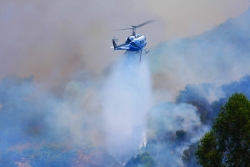“Those power lines are going to be a detriment to the air attack program and the ground program…More country is going to burn. It’s obvious.” – Bob Robeson, retired Division Chief, California Department of Forestry and Fire Protection (Cal-Fire)
 By Miriam Raftery
By Miriam Raftery
June 1, 2010 (Lakeside) – Swift attacks by aerial drops and ground crews narrowly succeeded in saving threatened homes Saturday along Highway 67 in the Slaughterhouse Canyon area of Lakeside, where several small fires started by a vehicle's catalytic converted merged into a 30-acre brush fire. But ECM columnist Dennis Richardson, an eyewitness to the firefighting efforts, raises a troubling concern.
Fires were burning directly along the route of the Sunrise Powerlink high voltage lines planned by SDG&E, he noted. (See map; fire was located between CP37-2 and CP31-2): http://www.cpuc.ca.gov/environment/info/aspen/sunrise/pmr/sdge_final_pmr_fig38.pdf .
“The Cal-Fire aerial firefighters would not have been able to work this fire until it burned out from under the transmission wires,” Richardson stated. Saturday’s fire occurred in spring, when grasses were still green and winds were only 5 mph. Had it occurred in dry conditions during summer or fall, with even moderate winds, Richardson warned, “No telling how many homes and lives could have been lost.”
Cal-Fire battalion chief Nick Schuler, when asked about Richardson’s concerns, said his agency “could not support such a broad statement.” He noted that the agency responds to thousands of wildfires each year, adding, “Our pilots are highly experience and deal with a multitude of aerial hazards while flying fires throughout California. Power lines are just one of these hazards.” Technologies and capacity of aerial firefighting plans have improved in recent years, he added.
But Bob Robeson, retired division chief in the San Diego area for the agency that later became known as Cal-Fire, shares Richardson’s concerns. In fact, he had already written and voiced concerns to Senator Dianne Feinstein and provided a taped oral presentationto the U.S. Forest Service (which has yet to approve the final section of Powerlink across USFS lands) before the Slaughterhouse Canyon fire.
 On Saturday, Robeson was on his front porch when he saw smoke and heard sirens, then headed over to watch the fire along Highway 67 just south of his own home for the next 20 to 30 minutes. “I’ve been on that ridge several times fighting fires in my day,” said Robeson, whose territory included the Ramona Air Attack base and East County areas north to Warner Springs and east to Borrego. “I was wondering if there was a power line there now, a big one like they are talking about running along this ridge where the fire is, how would we fight it?"
On Saturday, Robeson was on his front porch when he saw smoke and heard sirens, then headed over to watch the fire along Highway 67 just south of his own home for the next 20 to 30 minutes. “I’ve been on that ridge several times fighting fires in my day,” said Robeson, whose territory included the Ramona Air Attack base and East County areas north to Warner Springs and east to Borrego. “I was wondering if there was a power line there now, a big one like they are talking about running along this ridge where the fire is, how would we fight it?"
He concluded, "It’s going to complicate the heck out of this whole area.” Lakeside’s El Monte Valley already has numerous power lines that complicate firefighting, he added. “Once you have power lines that large and that tall, running north and south, east and west in very close proximity to themselves, it creates a total problem with your air attack program.”
Firefighters need to douse fires while they are small, he explained. “Underneath those lines, you have to wait until the fire comes out and can safely be worked with helicopters and fixed wings.” About 50% of the time, such waits result in a fire “running hard and getting larger as it goes,” he said. “More country is going to burn. It’s obvious…When you have so many power lines, it is going to alter their initial attack with the aircraft. They cannot deny that.”
In very high Santa Ana winds, air tankers and helicopters may not be able to fly. But with moderate 15-25 mph winds, “every second counts for the first 20 minutes,” said Robeson, noting that air tankers need to reach a fire in the first 20 minutes to confine it so ground crews can surround it and douse the blaze. “But with power lines, you have to take a different route in,” he said, confirming that lines along Highway 67 would cause delays in getting air power on scene—even if the lines have been depowered by SDG&E. (SDG&E did not return ECM's call asking how quickly they can depower a line, or whether technology now exists to do so remotely. Robeson said when he was fighting fires, they had to wait for an SDG&E crew to arrive and literally cut the lines.)
If lines are still energized, the problem is even more severe. “Smoke columns that get into power lines can ground out and create arcs down to the ground, since smoke itself is a carbon, a burning fuel,” Robeson said. Retardants dropped too close to power lines can also create arcs down to the ground. “Those are all hazards I’ve worked with in my 38 years with the California Department of Forestry and also the City of San Diego,” he confirmed. “I’ll tell you, those power lines are going to be a detriment to the air attack program and the ground program.”
He recalled an incident I El Monte Valley around Lake Jennings. “Air crews could not effectively slow the fire because you had power lines there,” he said. “They could not even get in to protect a campground…There are a lot of power lines running across there now and many are already very tall.” If Powerlink is built, he predicted, “You’re going to take one to three air miles where it would be nuts to try and fly in there with dense smoke during a fire.”
Dropping water or fire retardant chemicals on a wildfire in smoky conditions is risky business even for pilots familiar with local terrain. Asked how often out-of-area pilots have been brought in to fight fires here in the past, Robeson replied, “Quite often. We could have an air attack from another jurisdiction fly in here and not even have any idea where these power lines are.”
He recalled a fire in Penasquitos, where a large air tanker had to knock down a fire quickly to save homes. “The wind caught the fire retardant and it got into power lines,” he said, adding that the retardant also blew into a residential area. “One woman fell and burned her leg…People had to go without power. The pilot was worried about a lawsuit,” he said, adding, “Power lines took a simple thing and turned it into a mess.”
Robeson, who is also chair of the Eucalyptus Hills Fire Safe Council, expressed concern that a fire in Lakeside could spread into Eucaylptus Hills and points further west, including Santee, Poway, Scripps Ranch and Rancho Bernardo, if Sunrise Powerlink is built above ground as SDG&E proposed.
“We need power, but why can’t we put it underground?” Robeson asked. “Yes, it’s expensive, but they did it with lines in Santee and they’re doing it in Alpine.” Costs of undergrounding would be far less than the cost of another devastating fire such as the 2003 Cedar Fire or 2007 wildfires, which cost lives, burned thousands of homes and caused the largest evacuations in U.S. history from a natural disaster.
Richardson noted that a fire in Mira Mesa last week was caused by a hawk flying into a power line, a situation fire officials called “common.” He pointed out that El Monte Valley is home to nesting raptors—and Powerlink towers are proposed to dominate ridgelines in the area.
“Just wait until the golden eagles on El Capitan hit the new transmission lines,” Richardson observed.
Robeson said he believes that state fire officials are minimizing the risks from Powerlink due to political pressures. “Everybody is ducking their heads,” our region's former Division Chief concluded.













Comments
Thank you!
Thank you Robeson for coming out and exposing the truth and revealing the political pressure that Cal Fire and others are under. To me it is apparent that we need to do everything we can to minimize the risk of fires. The Sunrise Powerlink would be horrific to our county, and if built... it NEEDS to go underground!